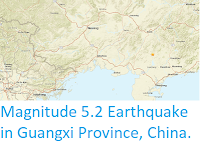A train has derailed after hitting a landslide in Hunan Province, China, on Monday 30 March 2020. The driver of the train, a Guangzhou Railway Group operated service between Jinan and Guangzhou, attempted to brake when he saw the landslip, on the southbound section of rail between Matianxu and Qifengdu stations in Yongxing County, but was unable to prevent the collision. The incident resulted in six carriages derailing, one of which subsequently caught fire, one person dying, and 127 people being injured, four of them seriously.
Rescue workers attend a train derailment caused by a landslide in Hunan Province, China, on Monday 30 March 2020. Hunan Emergency Management Department Fire Rescue Bureau.
The incident is reported to have occurred following several days of heavy rain associated with the onset of the Monsoon Season, which typically lasts from the begining of April to the middle of August in Hunan. Landslides
are a common problem after severe weather events, as excess
pore water pressure can overcome cohesion in soil and sediments,
allowing them to flow like liquids. Approximately 90% of all landslides
are caused by heavy rainfall.
Engineers begin the process of clearing the site of a train derailment in Hunan Province on 30 March 2020. AFP.
Monsoons
are tropical sea breezes triggered by heating of the land during the
warmer part of the year (summer). Both the land and sea are warmed by
the Sun, but the land has a lower ability to absorb heat, radiating it
back so that the air above landmasses becomes significantly warmer than
that over the sea, causing the air above the land to rise and drawing in
water from over the sea; since this has also been warmed it carries a
high evaporated water content, and brings with it heavy rainfall. In the
tropical dry season the situation is reversed, as the air over the land
cools more rapidly with the seasons, leading to warmer air over the
sea, and thus breezes moving from the shore to the sea (where air is
rising more rapidly) and a drying of the climate.
Diagrammatic representation of wind and rainfall patterns in a tropical monsoon climate. Geosciences/University of Arizona.
See also...
Follow Sciency Thoughts on Facebook.









